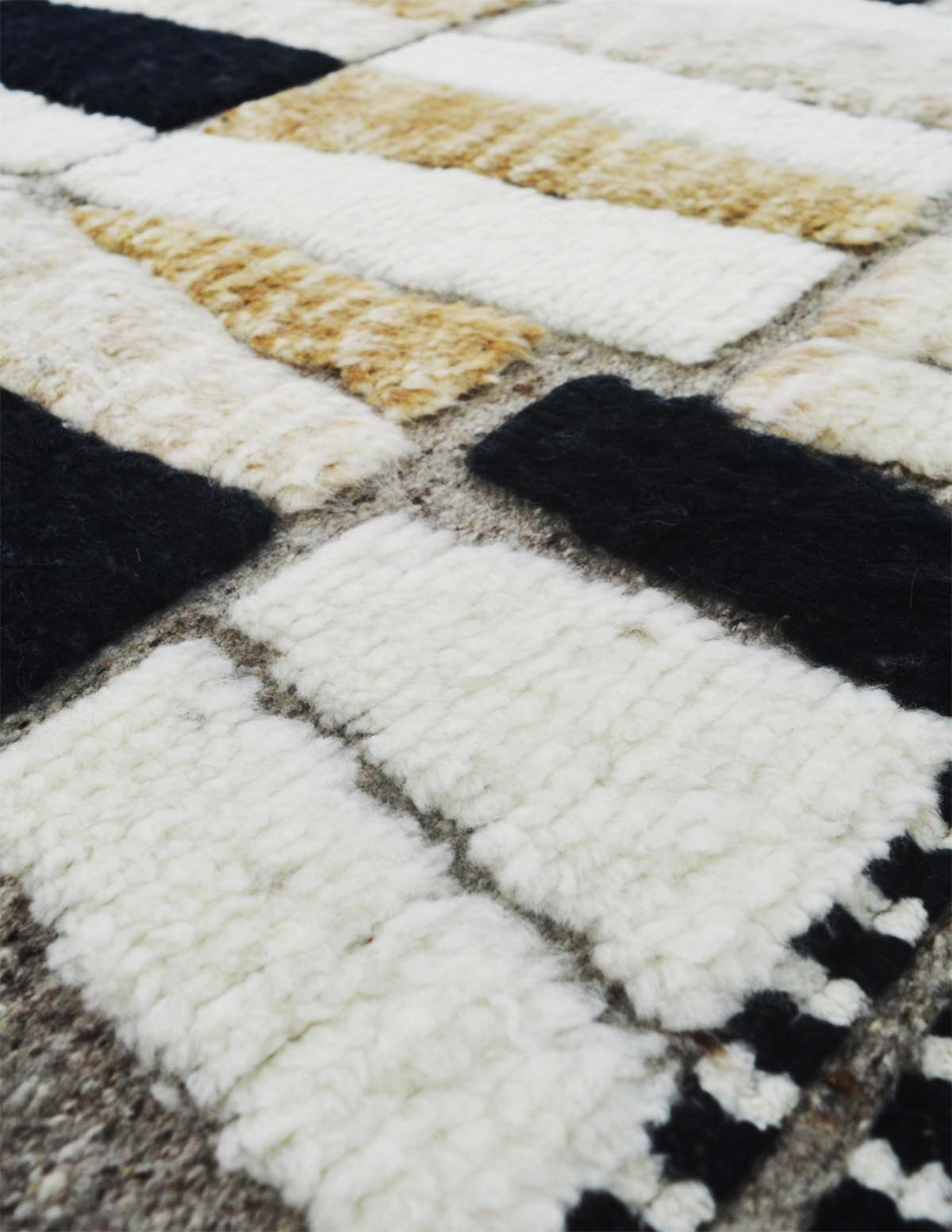RuG GuiDE
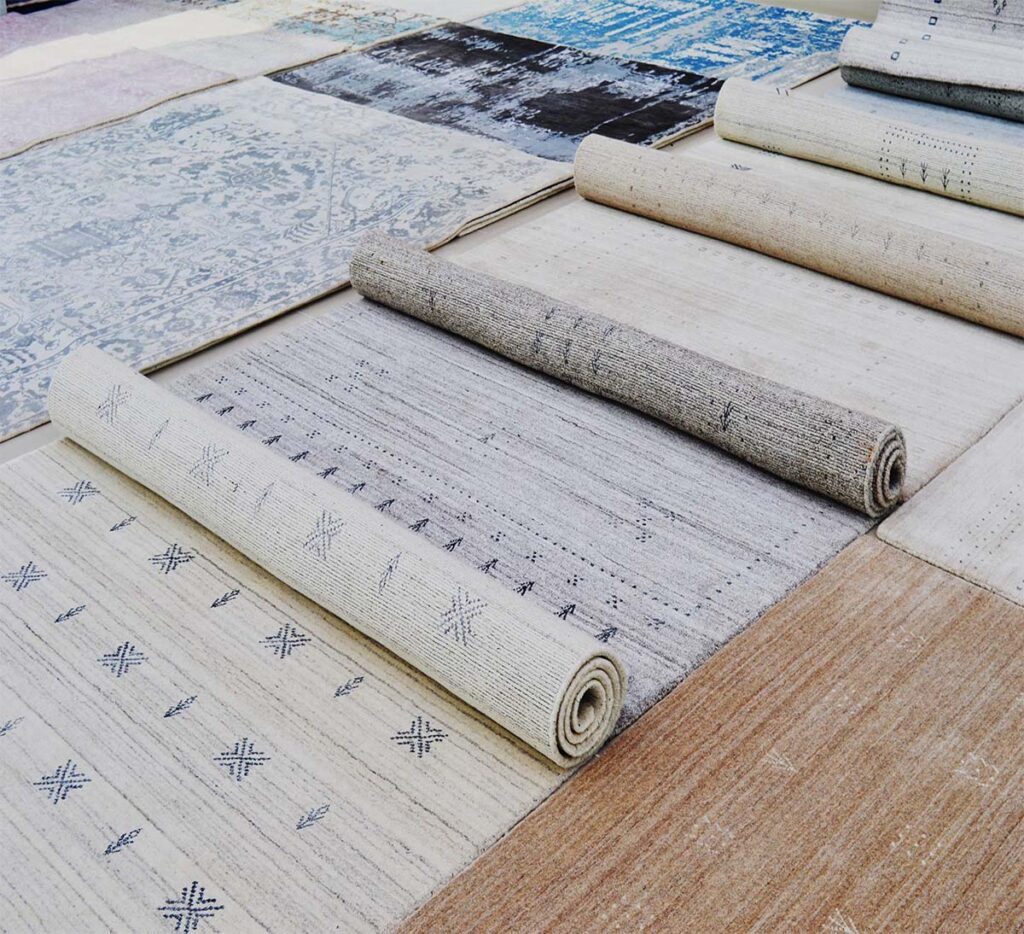
OVERVIEW
Adding a rug is one of the easiest waysto freshen the look of a room. Rugs can anchor aroom, define it, add warmth and help layer aroom’s decor. All Mabood International Rugs are made from the finest quality materials to ensure strength and durability. But, like any investment, a rug must be properly taken care of if it is to last. Our Rug Guide provides you with valuable tips and resources to help ensure your rug can be enjoyed for years to come.
COMMON CONCERNS
All Mabood International rugs are handmade by skilled artisans in a speciality manufacturing facility, and are checked to meet quality standards before shipment. We stand behind our products 100% but understand that there are some common concerns about rugs that may require further explanation.
DESIGN, COLOR &SIZE
- Handmade rugs may have slight variation in design, color and size (3%-5%) which are not considered defects.
- Mabood Internationaluses the Pantone TPX color guide when assigning colors to its products. Pantone TPX colors provide a standard “language” that is understood by designers around the world, helping to ensure consistency and accuracy when referring to color.
- Handmade rugs are made by artisans and are one-of-a-kind pieces. As such, they may have subtle color variations (3%-5%) which are not considered defects due to the inherent characteristics of natural fibers and dyes.
- While the Mabood Internationalcatalog and website provide an excellent guide for evaluating arug’s design and general appearance, samples provide the best way to accurately evaluate color.
- Some fibers are more reflective than others and, depending on the lighting in the room in which the rug will be placed, the rug may appear lighter or darker than it does in product photography. For example, aviscose rug will have more sheen and light-reflective properties than a natural fiber rug, and color will vary more when the rug is placed in different environments.
- A rug’s colors can also vary depending on the angle at which the rug is being viewed. For instance, when looking at one end of the rug, you will see the flat surface of the fibers reflecting light. From the opposite side, you will see the trimmed end of the fibers, which reflect light in avery different way.
SHEDDING
- Shedding is considered normal and will vary depending on the construction and content. Shedding will usually subside over time, although some rugs may have mild shedding for the lifetime of the rug. It typically takes 20-25 vacuumsat a minimum (depending on foot traffic) to curtail shedding.
- Hand tufted rugs will have the highest shedding, while machine woven rugs have the lowest shedding.
- Wool and viscose have the highest shedding, while polypropylene, olefin, polyester, acrylic and nylon have the lowest shedding.
SPROUTS
- Sprouting is anormal part of the break-in process where loose yarns are pulled up above the surface of the rug. This is considered normal and will vary depending on the rug construction and content.
- To remove sprouts, use scissors to carefully trim the sprouting yarn even with the pile.
- Do not pull sprouts out of the rug, as this causes additional sprouting and damage.
Hand hooked rugs will have the highest sprouting, while machine woven rugs have the lowest.
CREASES
Because rugs are rolled for shipping and storage, they may have creases or curling when first unrolled. Creases should disappear within aweek or two when the rug is laid out flat. Reverse rolling the rug overnight will help to release creases.
ODOR
- Dyes, yarns, backing and packing material all have natural odors that are sometimes magnified after being sealed for shipping and storage.
- Odors should dissipate within aweek once the rug is removed from the packaging.
FADING
- The colors in your rug will fade with time, even if the material is fade resistant.
- Direct sunlight will cause faster fading than indirect sunlight.
- Rotating your rug every 3-6 months will distribute the fading more evenly over the rug which reduces the appearance of fading.
- Jute and Wool will fade the fastest.
Polypropylene and olefin are the most fade resistant materials because they are solution dyed.
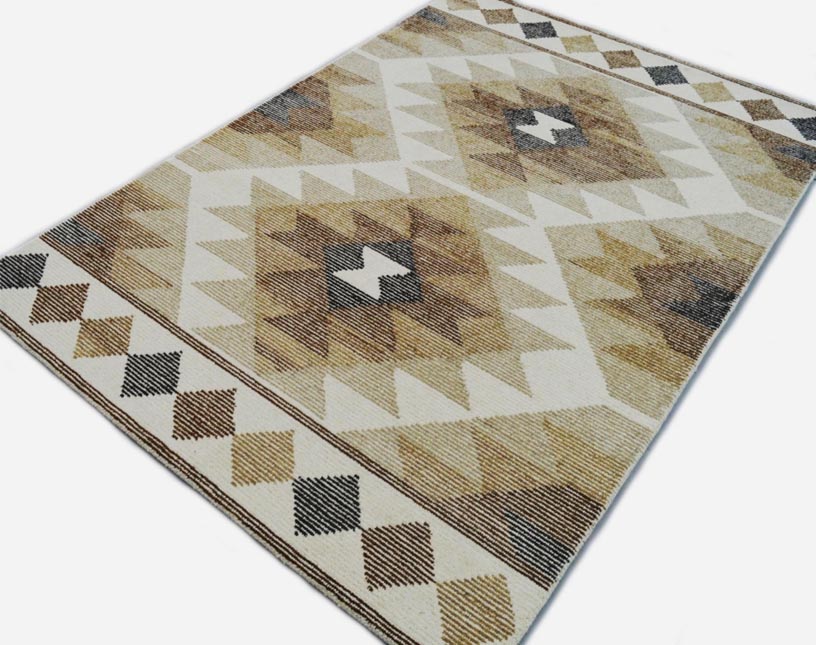
RUG CONSTRUCTIONS
Below is a brief overview of the most common rug constructions. No one construction or material is better than any other, but they each have inherent characteristics that make them better suited for different uses. Learn about the advantages anddisadvantages of the different constructions to find what works best for you.
………………………….. | CONSTRUCTION | HOW IT’S MADE | BENEFITS | OTHER CHARACTERISTICS |
|---|---|---|---|---|
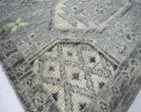 | Hand Knotted | Each knot is tied by hand,one-by-one. | Artisan product, highest perceived value, very durable (except in delicate materials), can achieve intricate details | Size/design/colormay vary slightly, higher price than other constructions. |
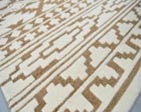 | Hand Tufted | Hand-operated tool is used to punch yarn through a canvas. | Best-selling construction, many textures are possible; predominantly cut pile. | Size/design/color may vary slightly, more shedding than other constructions. |
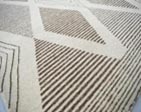 | Hand Hooked | Hand-operated tool is used to punch yarn through a canvas. | Crafted/artisanal look; predominantly looped pile. | Size/design/color may vary slightly, more sprouting than other constructions. |
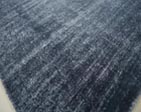 | Hand Loomed | Woven on a large, hand-operated loom. | Can be cut pile, loop pile, or cut and loop pile; often a solid color base is hand carved to create a subtle design. can also be overtufted or printed to create a textural/colorful design. | Size/design/color may vary slightly, limited to simple/ border designs or solids. |
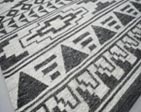 | Hand Woven (flatweave, dhurrie, kilim, peddle-weave) | Woven by hand on an upright loom or peddle loom. | Shedding is less than other hand made constructions, often reversible and foldable. | Size/design/color may vary slightly, can feel coarse because there is no pile, limited to designs which are geometric, simple, or repetitive. |
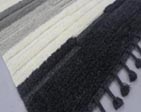 | Hand Woven (shag, texture) | Woven by hand on a pit loom or punja loom. | Highly textural, high perceived value. | Size/design/color may vary slightly, typically very thick which can be difficult to walk on or place furniture on. |
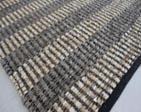 | Hand Crafted | Animal hides are cleaned and finished by hand; other unconventional rug techniques may be categorized as Hand Crafted. | Natural/craftedlook. | Size/shape/coloration will vary from piece to piece since every natural animal hide is completely unique. |
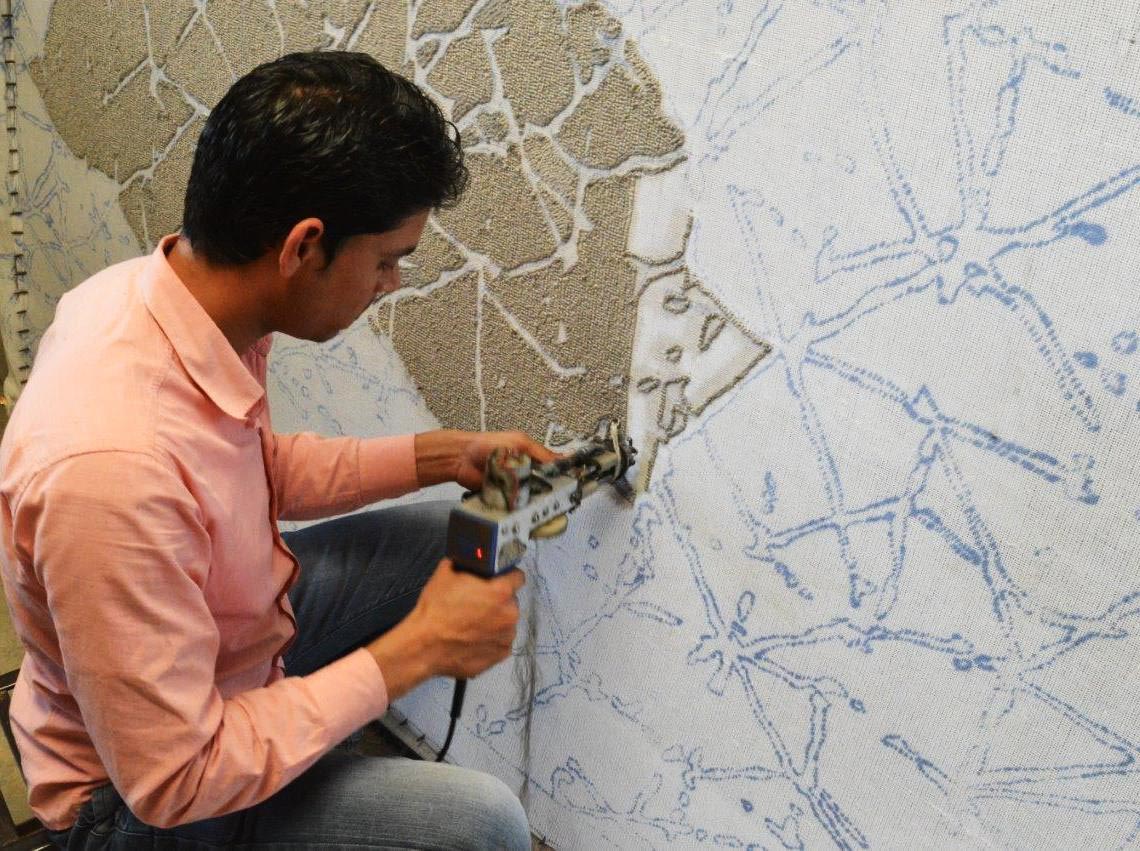
RUG MATERIALS
There are countless rug materials, especially considering that two, three or even more materials may be used in asingle rug. Below are some of the essential materials used in Mabood International. Each material has specific benefits andcharacteristics that are unique based on origin.
WOOL
Protein based fiber from sheep’s fleece is spun into yarn. Wool yarn is sustainable, biodegradable, highly durable and highly resilient with natural oils that provide softness. Dyed and undyed wool products will vary in shade from piece to piece and will fade with exposure to sunlight. All wool sheds, however this varies depending on the quality and will reduce over time.
WOOL-FELTED
Protein fiber from sheep’s fleece which is agitated, usually with water, at ahigh temperature so the fibers mat together. Wool yarn is sustainable, biodegradable, highly durable and highly resilient with natural oils that provide softness. Dyed and undyed wool products will vary in shade from piece to piece and will fade with exposure to sunlight. All wool sheds, however this varies depending on the quality and will reduce over time.
NEW ZEALAND WOOL
Protein based fiber from New Zealand sheep’s fleece is spun into yarn. This wool is higher quality than normal Wool and has more softness, natural sheen and less shedding. Dyed and undyed wool products will vary in shade from piece to piece and will fade with exposure to sunlight. All wool sheds, however this varies depending on the quality and will reduce over time.
JUTE/SEAGRASS/SISAL
Cellulose fiber extracted from a plant then spun into yarn. This material is sustainable, biodegradable, durable and affordable. It is also moisture resilient and embodies natural color variation. It feels coarse and has high shedding if used in pile construction but minimal otherwise. Dyed and undyed colors will vary based on the time of year when the fibers are harvested.
POLYESTER/ACRYLIC/POLY ACRYLIC/ NYLON
Synthetic (man-made) made by extruding polymers or petrochemicals and yarn-dyed. It is highly durable, moisture and stain resistant with minimal-to-no shedding. This material has aslight chemical odor which will fade over time.
POLYPROPYLENE/OLEFIN/POLYOLEFIN
Synthetic (man-made) made by extruding polymers or petrochemicals and solution-dyed in a liquid state before it is formed into yarn. It is highly durable, moisture, fade and stain resistant, with minimal-to-no shedding or color variation. This material has aslight chemical odor which will fade over time.
HAIRON HIDE/SHEEPSKIN
Natural animal rawhides with hair/fur still attached are cleaned and finished by hand. They are moisture resistant and biodegradable. Mabood International uses only cow and sheepskin hides and since no two animals have exactly the same markings or coloration, every product made with Hair on Hide or Sheepskin will have natural variation in shape, markings andcoloration.
SILKENZA
Silkenza is a supremely soft nylon dyed yarn with silk look like. Ideal for residential spaces. Silkenza Yarns have natural sheen & exhibit silk like features. Yarns made from Silkenza are ideal for luxurious home styling, it is high performance yarn with inherent resilience. Silkenza yarn are available in small batch sizes to meet customer requirements.
ECOSE
Ecose is a supremely soft, dyed BCF yarn, that eliminates carpet shedding unlike viscose and offers a natural hand-made look. Ecose is ideal for residential wall to wall carpets and decorative rugs. Carpets made with Ecose are stain resistant and durable even after extensive use.
TENCEL
Cellulose pulp from wood is first extracted using recyclable solvents and then spun into yarn. Tencel imitates the look and texture of silk at a lower price and is sustainable and biodegradable. It is soft with a silky appearance and lustrous sheen. It is not recommended for high traffic areas due to high shedding since nonresilient fibers can mat and make stains difficult to clean. Tencel is more durable then viscose and will shed less than viscose. However, it is less durable that synthetic fibers and wool.
VISCOSE
Hybrid of natural cellulose pulp and synthetic fibers is regenerated through chemical processing and spun into yarn. This material imitates the look and texture of silk at a lower price. It is biodegradable with a soft appearance and has a silky feel with lustrous sheen. It is not recommended for high traffic areas due to high sheddingsince non resilient fibers can mat and make stains difficult to clean.
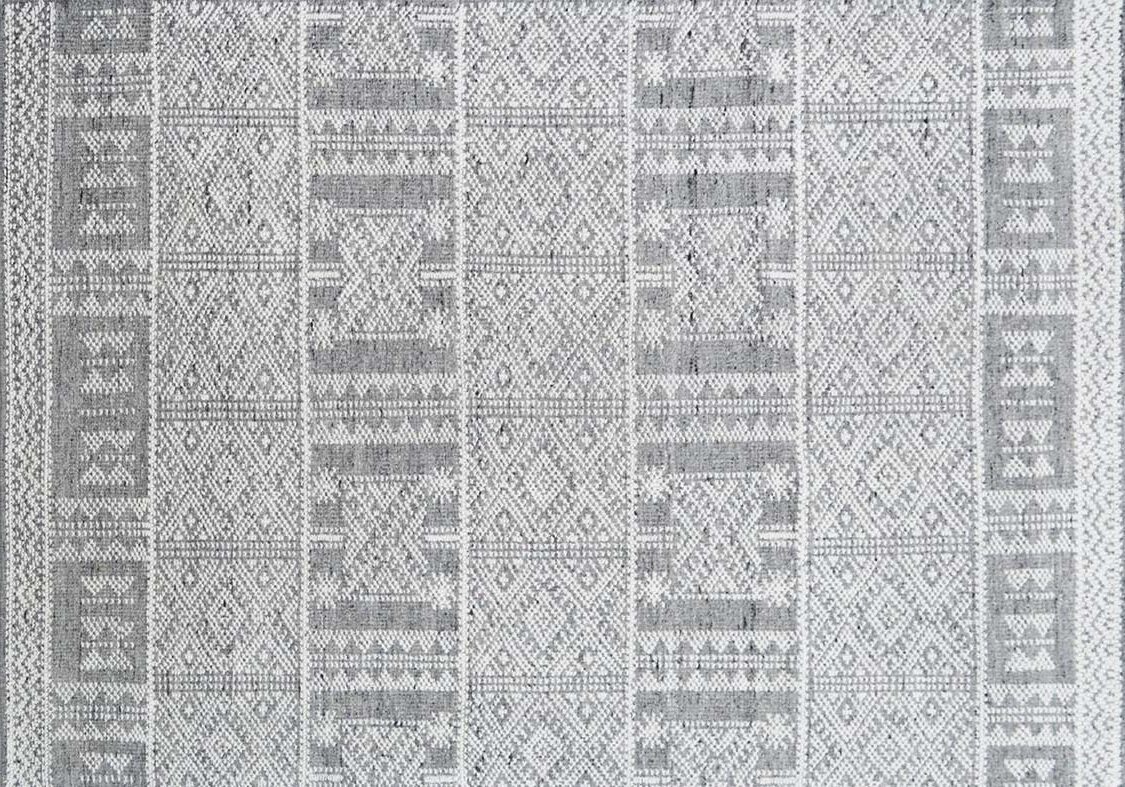
RUG SIZING
Rug sizing and placement can make or break any room decor. Choosing the correct rug size is essential to complementing a space properly and making a room look the best it can. When selecting a rug, consider your furniture and take note of the various layout options available. A rug that is too small or ill-proportioned to the room can make the space feel smaller or look imbalanced. Choosing the right rug size will not only help define the areaandmake it feel more refined andcohesive, but it can also enhance the overall acoustics of the space.
LIVING ROOM
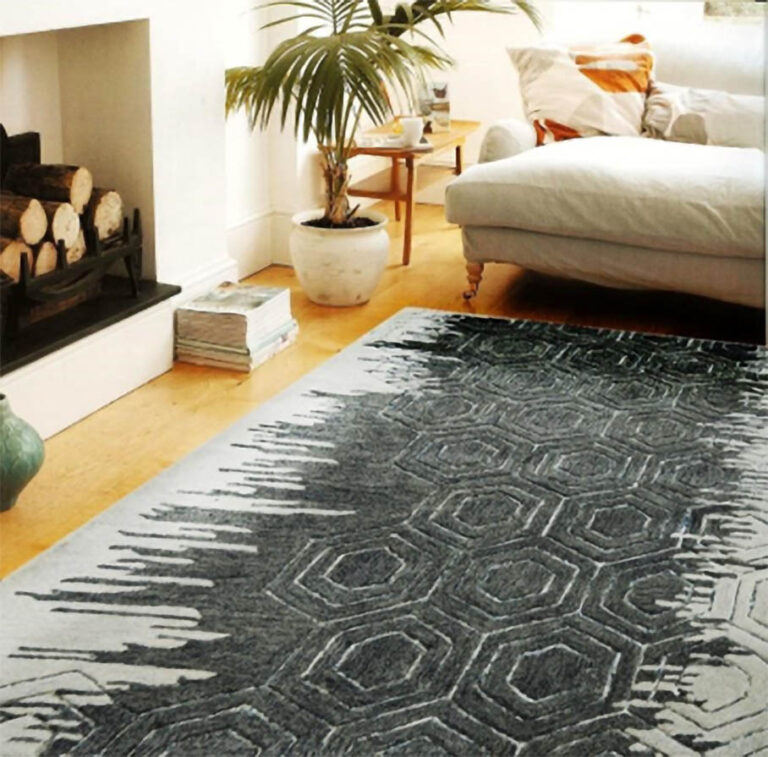
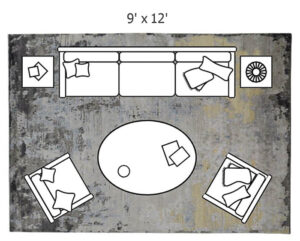 LIVING ROOM #1: ALL LEGS ON THE RUG
LIVING ROOM #1: ALL LEGS ON THE RUG
Create a cohesive look in your living room with an area rug large enough to accommodate all of your furniture. The key to styling your seating area on top of a large rug is to ensure that the rug extends at least six inches past each piece of furniture. We recommend a rug that is 9′ x 12′ or larger, leaving an equal 12″ to 18″ of exposed floor on all sides to create a border around the rug. Thisis a nice option for larger, open concept rooms. It allows the furniture to “float” in the center, helping to accentuate the seating area and create distinction in the room.
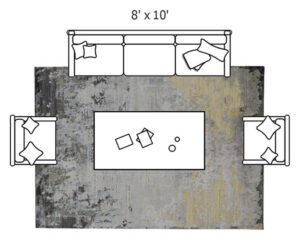 LIVING ROOM #2: FRONT LEGS ON THE RUG
LIVING ROOM #2: FRONT LEGS ON THE RUG
Tuck the rug under the front legs of your sofa and chairs to keep your seating area unified. The back legs of the sofa can be situated on or off of the rug, depending on personal preference. This is the most popular arrangement for living rooms and works especially well if a sofa is up against a wall. We recommend a rug that is at least 8′ x 10′. Leaving a space of 18″-24″ on all sides of the rug will create a natural border to frame your living space.
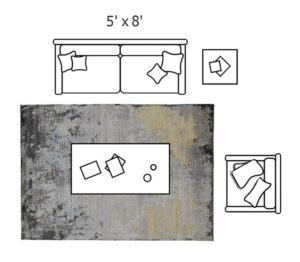 LIVING ROOM #3: ALL LEGS OFF THE RUG
LIVING ROOM #3: ALL LEGS OFF THE RUG
If you’re working with a smaller room (or smaller budget), consider a rug that floats in the center of your seating arrangement. A rug that is at least 5′ x 8′ works best in a room that is 10′ x 12′ or smaller. This would leave about 2 feet of flooring bordering the rug on each side. For the best proportion, the rug should be a bit longer than your sofa. Place the rug a few inches in front of the sofa or centered with alternative seating on the perimeter. If the rug is under a coffee table, make sure the rug is large enough to rest under all four legs of the table.
DINING ROOM
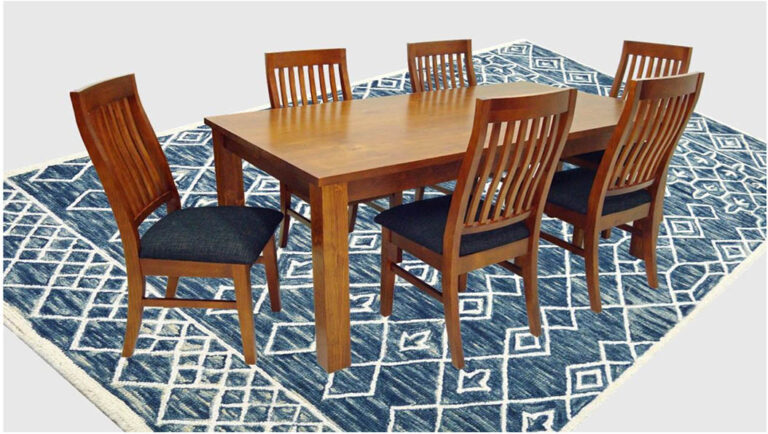
In the dining room, you’d typically place the rug directly underneath the table and centered in the space. Let the dining chairs sit completely on the rug, with enough room to comfortably pull the chairs out and still remain on the rug. Ideally this would mean that your rug is larger than your dining table by at least 30 inches on all four sides. In this instance we recommend a rug that is 8′ x 10′ or larger. For instances where the dining room table is round you might consider using a round rug sized 8′ or more to complement and unify the space.
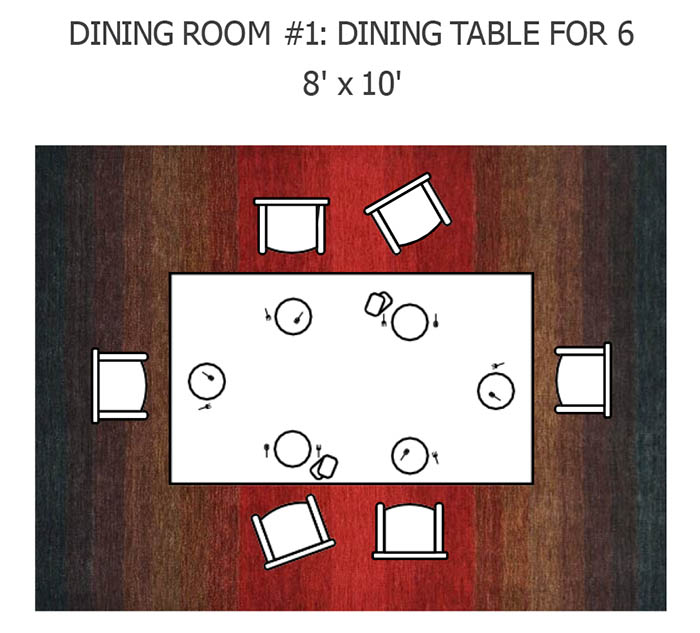 | 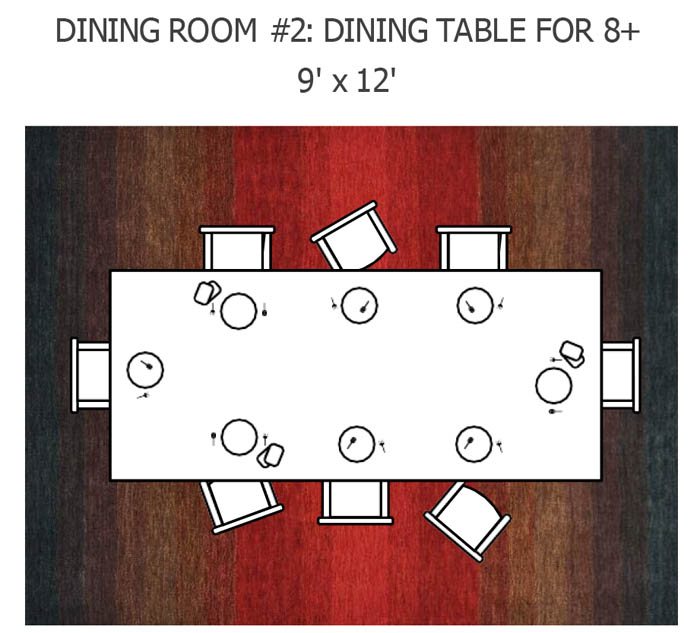 | 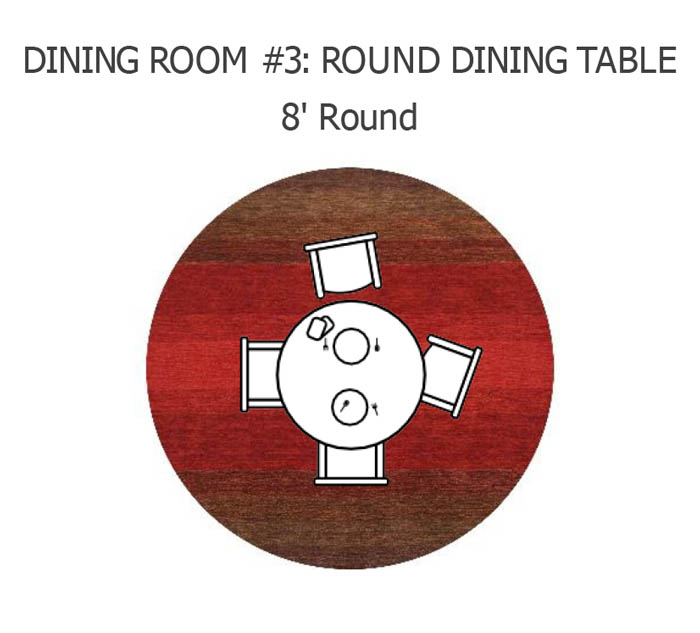 |
|---|



BEDROOM

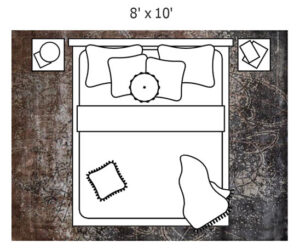 BEDROOM #1: ALL FURNITUREON THE RUG
BEDROOM #1: ALL FURNITUREON THE RUG
We recommend rugs 8′ x 10′ or larger if placing king or queen sized beds with adjacent nightstands on the rug. It is best not to allow the rug to encroach upon any main walkways and, when possible, leave a minimum of 2 feet of soft rug underfoot around the bed.
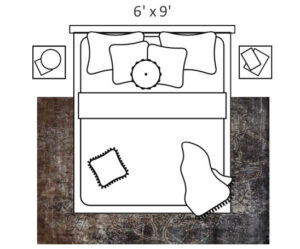 BEDROOM #2: JUST THE BED ON THE RUG
BEDROOM #2: JUST THE BED ON THE RUG
If you have attractive flooring but want to add some cushioning for comfort, tuck a 6′ x 9′ rug under the bed just up to the nightstands so that only the lower two thirds of the bed sits on the rug. Alternatively, if you have wall-to-wall carpeting, and are just adding a rug for some color or texture, then tuck a 5′ x 8′ rug under the bed so that only the lower third of the bed sits on the rug.
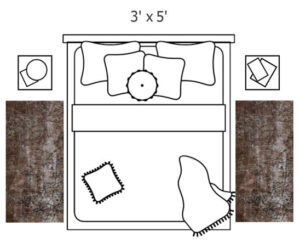 BEDROOM #3: RUNNERS ON EACH SIDE
BEDROOM #3: RUNNERS ON EACH SIDE
A more budget friendly option to provide softness underfoot is to place two runners on either side of the bed. This flexible choice works for spaces and beds of all sizes. You can place the runners completely under the night stand, or go with a shorter 3′ x 5′ rug placed a few inchesin front of the nightstand on each side of the bed. The rug or runnershould be abit wider than your nightstand.
KITCHEN
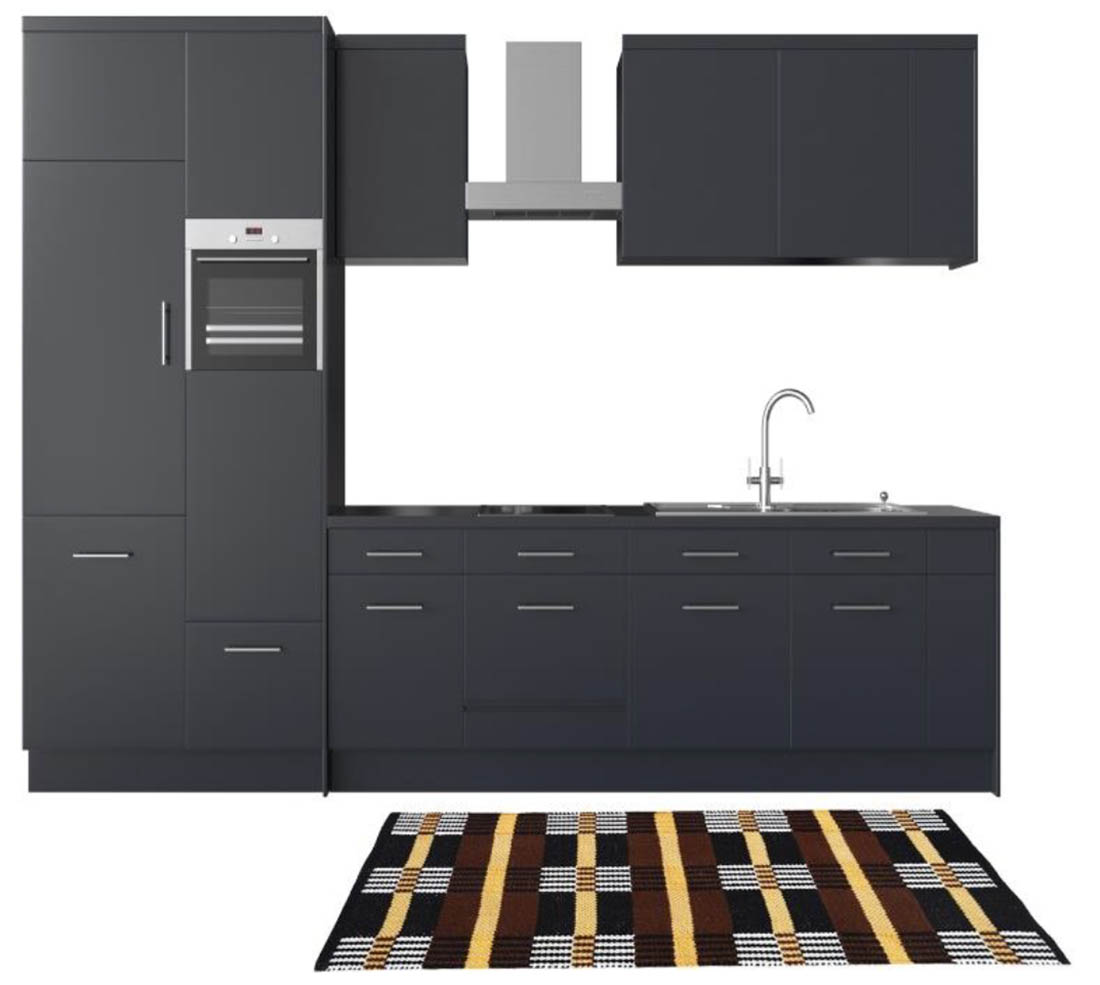
Placing a rug in your kitchen adds style and provides warmth and comfort underfoot during daily routines such asdining, cooking and washingdishes. Regardless of the size and shape of your kitchen, the space in front of the kitchen sink is usually the best, most functional place for a rug. Depending on the configuration and size of your kitchen, we recommend a 3′ x 5′ or 5′ x 8′ rug in front of the sink. A 2.5′ x 8′ to 2.5′ x 12′ runner is ideal for filling narrow spaces, like those between a kitchen island and nearby counters. For larger open kitchens, you might also consider adding a centered area rug beneath your kitchen table. Since this rug will live in a high-traffic area and be prone to spills and other messes, choose arug that is stylish, durable andeasy to clean. Outdoor rugs are a great option for the kitchen.
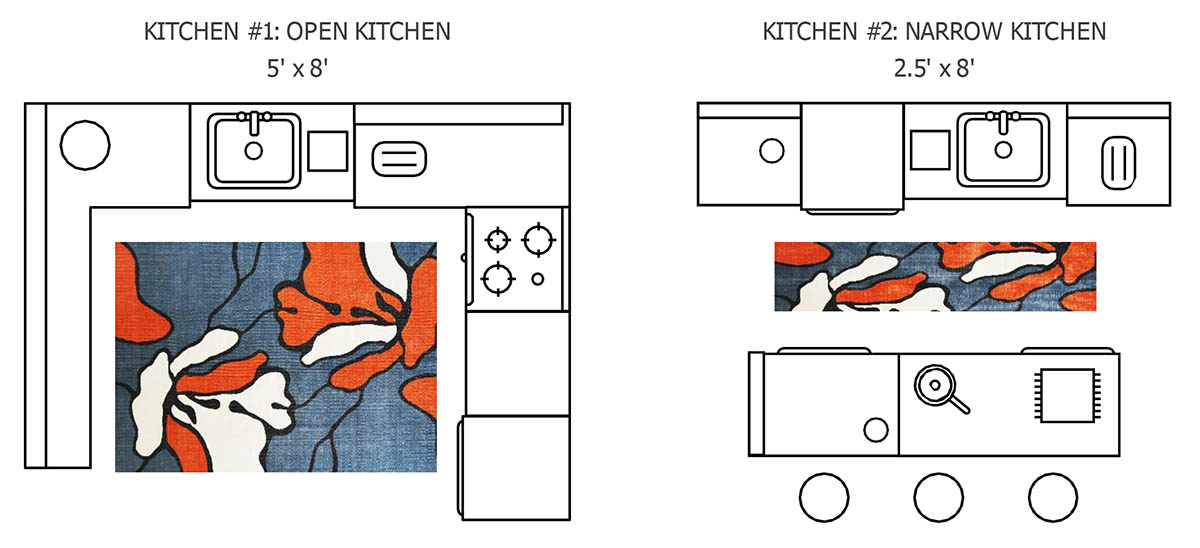
RUG CARE & CLEANING
The following are general care and cleaning instructions that apply to any type of rug.
VACCUMING
• Canister vacuums without beater bars are the optimal type of vacuum to use on rugs.
• Brooms and manual sweepers are also a gentle and effective way to clean rugs.
• If you must use an upright vacuum, use the handheld attachment whenever possible.
• If you are unable to use the handheld attachment on your upright vacuum,turn off the vacuum’s beater bar.
• Ifthe beater bar cannot be turned off, set it on the highest position possible before vaccuming.
• Refrain from running the vacuum over the edges of the rug or the rugs. Instead, use the handheld attachment or carefully place the vacuum on the rug.
• If a rug isreversible remember to vacuum both sides
CLEANING SPILLS
• Clean spills immediately. Once a stain is set is becomes much more difficult to clean.
• Scrape off any food or debris with a dull instrument.
• Blot the spill with a dry cotton cloth or a clean paper towel.
• Work from the outer edges of the spill towards the center to prevent spreading.
• Never rub a spill asthisforces the spill deeper into the rug.
• To remove any residual staining, dampen a cotton cloth or clean paper towel with clean, cold/lukewarm water. Gently blot with the damp cloth and quickly absorb the moisture on the rug.
• Please note that Viscose and Tencel rugsshould never be cleaned with any water or liquid.
PROFESSIONAL CLEANING
• Handmade rugsrequire a different cleaning process than wall-to-wall carpet, so be sure to choose a professional rug cleaning expert.
• Inspect the rug with the cleaning expert prior to cleaning.
• Get a signed receipt and guarantee of work before the work is performed.
• Any damage resulting from the professional cleaning process is the responsibility of the cleaner.
The following are additional considerations based on specific rug construction types or materials.
OUTDOOR RUG CARE
Outdoor Safe products require regular care and cleaning, and should be stored in when they are not in use. Leaving an outdoor rug in direct or indirect sunlight outdoors will cause rapid fading. Store the rug in the shadewhen not in use.Ifyou choose to leave your rug outdoors, shadeit with anawningor umbrella. Leaving anoutdoor rug in rain or humid weather will cause rapid deterioration and/or mold. Store the rug in a dry space when not in use. If a rug is left in the rain by accident, hang the rug over a railing in sunlight until it has completely dried. Outdoor Safe products that are damaged or aged prematurely due to negligence are not considered defective.
SPECIAL CARE BASED ON CONSTRUCTION
- Hand Knotted Rugs – Use extra caution and care when cleaning because of the high value of these rugs.
- Hand Woven (Flat Weave) – Regularly vacuum both sides of the rug to remove any grit that may cause
- premature wear. Hand Woven (Shag/Texture) -Use extra caution and care when vacuuming; alternatively, you can take the rugoutsideto shake it out.
SPECIAL CARE BASED ON MATERIAL
- Wool/NZ Wool – Mix asmall amount of dish soap with cold water to help remove stains; regular vacuuming will help to curtail shedding sooner.
- Polypropylene/Olefin/Polyolefin – Mix asmall amount of dish soap with cold water to help remove stains.
- Polyester/Acrylic/Poly Acrylic/Nylon – Mix asmall amount of dish soap with cold water to help remove stains.
- Jute/Seagrass/Sisal- Regularvacuuming will help to curtail shedding sooner.
- Viscose/Tencel -Never clean these rugs with water or any other liquid.
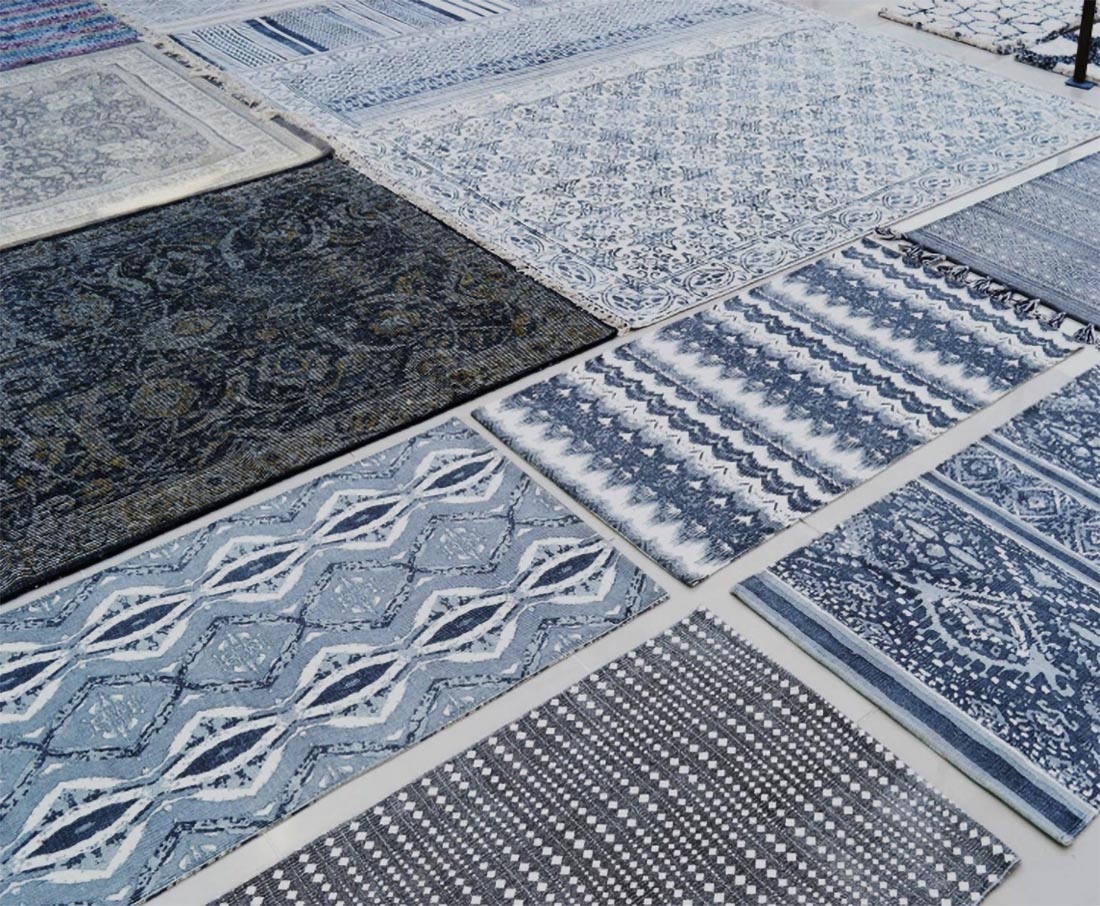
RUG PADS
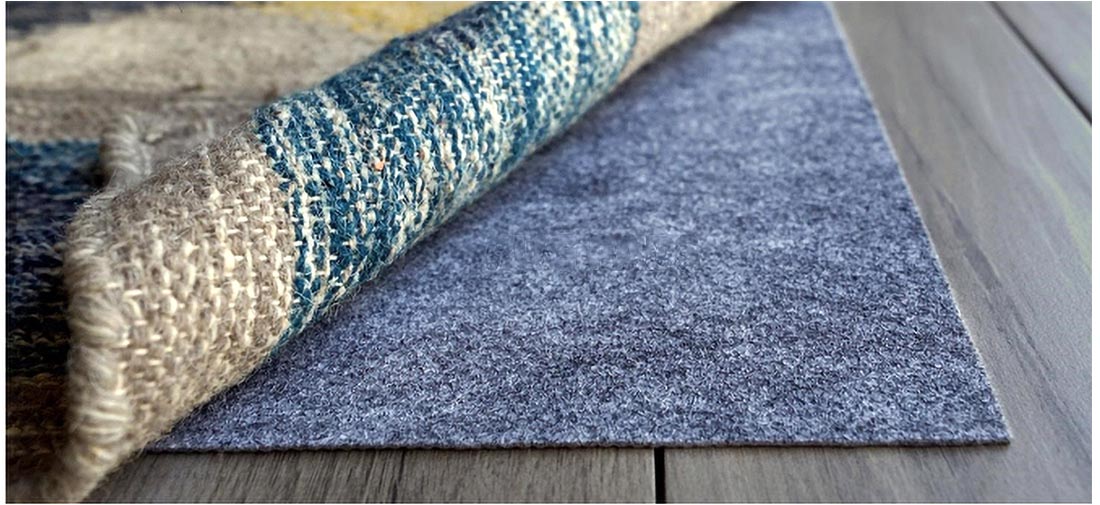
Rug pads provide a durable, long-lasting foundation. Not only do they bring comfort and cushion to your rugs, but they also protect floors underneath and reduce movement, bunching and slippage.
EXTENDS LIFE OF THE RUG
Reduces wear and tear and enhances air circulation between the rug and floor.
HELPS TO PREVENT ACCIDENTS
Holds the rug in place, preventing movement and slippage.
ADDS EXTRA COMFORT
Provides additional cushioning and support while protecting the floor underneath.
PROTECTS ALL FLOOR TYPES
Dual purpose felt pad protects on both hard surfaces and carpets. Do not use on vinyl, lacquered, acrylic or porous surfaces. Alwaysfollow the floor manufacturer’s recommendation.
HOW TO SIZE YOUR RUG PAD
To prevent tripping and to allow the rug to taper to the floor, make sure the rug pad is about an inch shorter than the rug from allsides. Rug pads can be trimmed with a sturdy pair of household scissors.
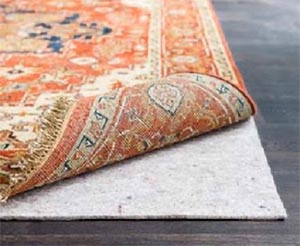 PREMIUM FELTED PAD
PREMIUM FELTED PAD
The Premium Felted rug pad is made of 100% felt from recycled virgin waste materials. It features a textured rubber waffle backing for excellent grip on surfaces and provides premium cushion and insulation.
- Our highest quality rug pad
- Maximum cushion, support and insulation
- Dual purpose: apply rubber side down on hard surfaces or apply felt side down for over-carpet application
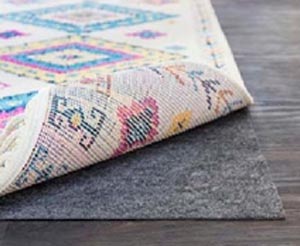 STANDARD FELTED PAD
STANDARD FELTED PAD
The Standard Felted rug pad is mad of 100% felt from recycled virgin waste materials. It features a slip resistant rubber waffle backing and has good overall cushioning.
- Lower profile for rugs that do not require the highest level of cushioning
- Good cushion,support and insulation
- Dual purpose: apply rubber side down on hard surfaces or apply felt side down for over-carpet application
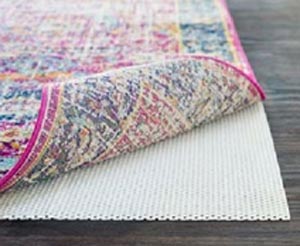 LUXURY GRIP
LUXURY GRIP
The Luxury Grip rug pad is made of 100% PVC. It features a thick, luxurious open weave construction that allows for proper air flow on hard surfaces.
- Soft and luxurious to the touch
- Good cushion,support and structure
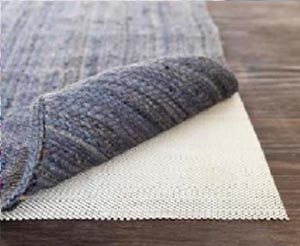 SUPPORT GRIP
SUPPORT GRIP
The Support Grip rug pad is made of 100% PVC. Featuring an open weave construction, it provides cushion and non-slip protection for hard surfaces.
- Easy to trim
- Soft cushion for hard surfaces
- Open weave construction facilitates efficient air flow and vacuuming
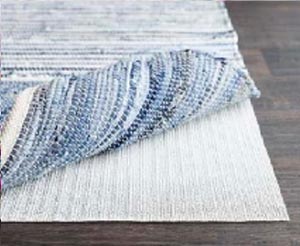 SECURE GRIP
SECURE GRIP
The Secure Grip rug pad is made of 100% PVC. It features a tight ventilated grid system and provides reliable protection for hard surfaces.
- Easy to trim.
- Provides non slip safe grip
- Open weave construction facilitates efficient air flow and vacuuming.
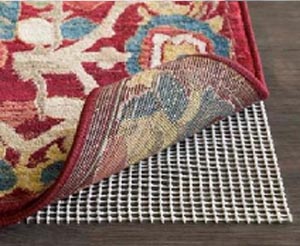 LOCK GRIP
LOCK GRIP
The Lock Grip rug pad is made of 100% PVC. It features an open ventilated grid system for maximum air flow while still providing protection for your rug at an exceptional value.
- Easy to trim
- Provides non slip safe grip
- Open weave construction facilitates efficient air flow and vacuuming
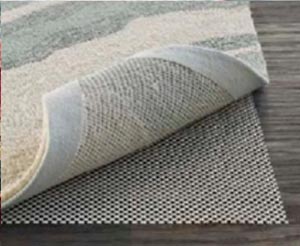
OUTDOOR PAD
The Outdoor rug pad is made of 100% Polymer Coated Polyester and is designed specifically for outdoor use. The open weave construction provides support and structure, and allows air to move under the rug to prevent mold growth.
- Easyto trim
- Mold and mildew resistant
- Helps outdoor rugs dry faster
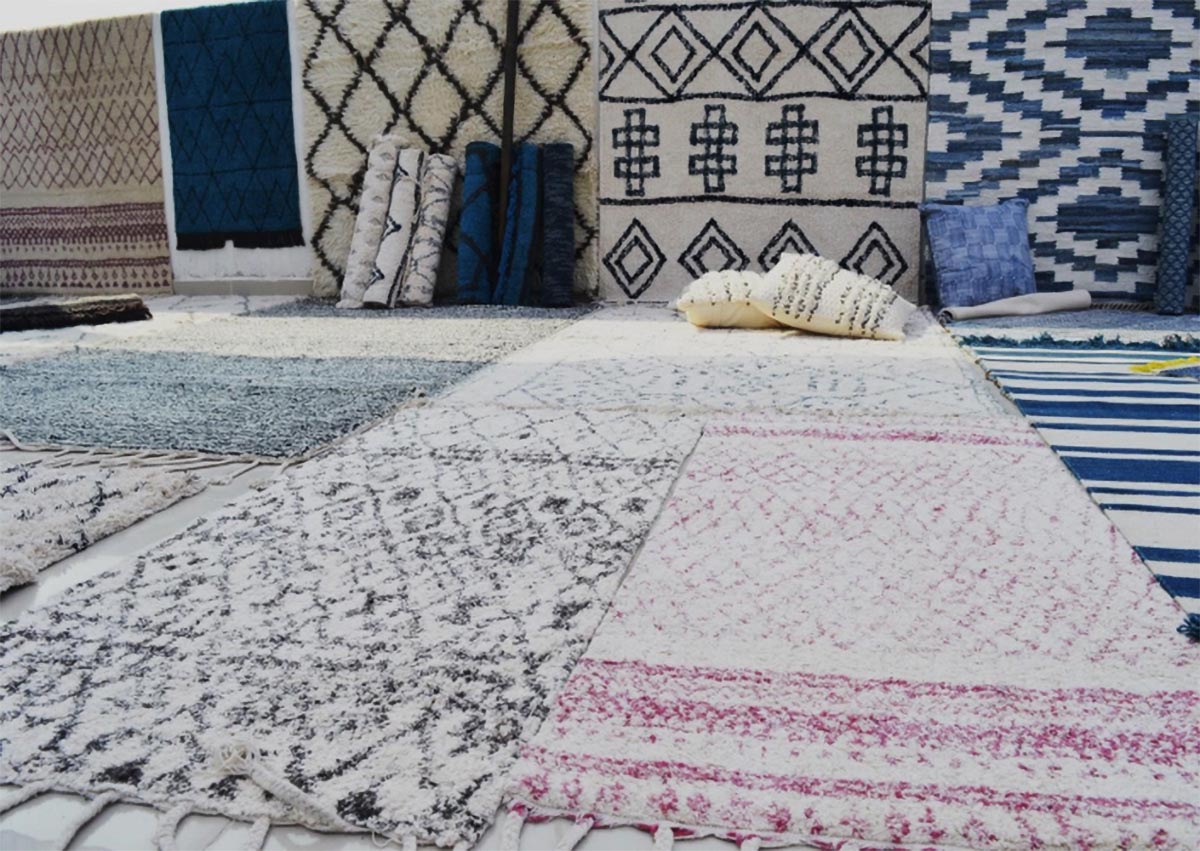
RUG STORAGE
Your rug is much more vulnerable to damage when it is in storage than in day-to-day use. A rug in storage, especially if it has not been professionally cleaned and properly prepared for storage, can be damaged in a relatively short time. We recommend taking the following precautions when storing your rug.
PROTECT YOUR RUG FROM MOTHS AND OTHER INSECTS
Any rug that is unattended (such as under furniture, in a dark area or in storage) or has foodstuff or protein substances, such as accumulated pet hair, can attract moths. Moths prefer laying their larvae in tightly rolled rugs. Apply aninsect and moth repellent that is specially designed for fabrics.
ROLL YOUR RUG FOR STORAGE
Unless arug is very old and fragile, rolling it for storage is generally the most beneficial. Todetermine which way to roll your rug, decide which is more fragile: the back of the rug or the pile where the fibers are. Ingeneral, the pile is more delicate, meaning you should roll your rug with the pile facing inward. Make sure to roll it as straight as possible. Ifpossible, roll the rug around acardboard support tube. Folding, rather than rolling arug, especially if it is stored for along period of time, may cause creases that may be difficult to steam or clean out. Poorly folded rugs can also develop cracked foundations.
WRAP THE RUG INA PROTECTIVE FABRIC
Wrap your carpet in a breathable fabric like a cotton sheet or muslin to keep it protected. If you want expertlevel protection, consider wrapping your rug in a polyurethane rug wrap. These rug wraps are designed to provide a superior barrier against dampness and insects and will be more effective than muslin. Do not use plastic to wrap your rug,since it will keep it from breathing.
STORE THE RUG OFF THE GROUND INA COOL, DRY ENVIRONMENT
If you must store the rug in an area such as a basement, garage or attic, make sure to elevate it off the floor and choose an area with the least amount of heat and humidity to prevent mildew.
UNROLL THE RUG AND CHECK THE RUG FOR SIGNS OF DAMAGE EVERY FEW MONTHS
To be safe, we suggest unrolling your rug once a month to make sure there is no evidence of insect infestation or mildew. Also, vacuum the area and the rug itself to eliminate any insect-attracting dust.
